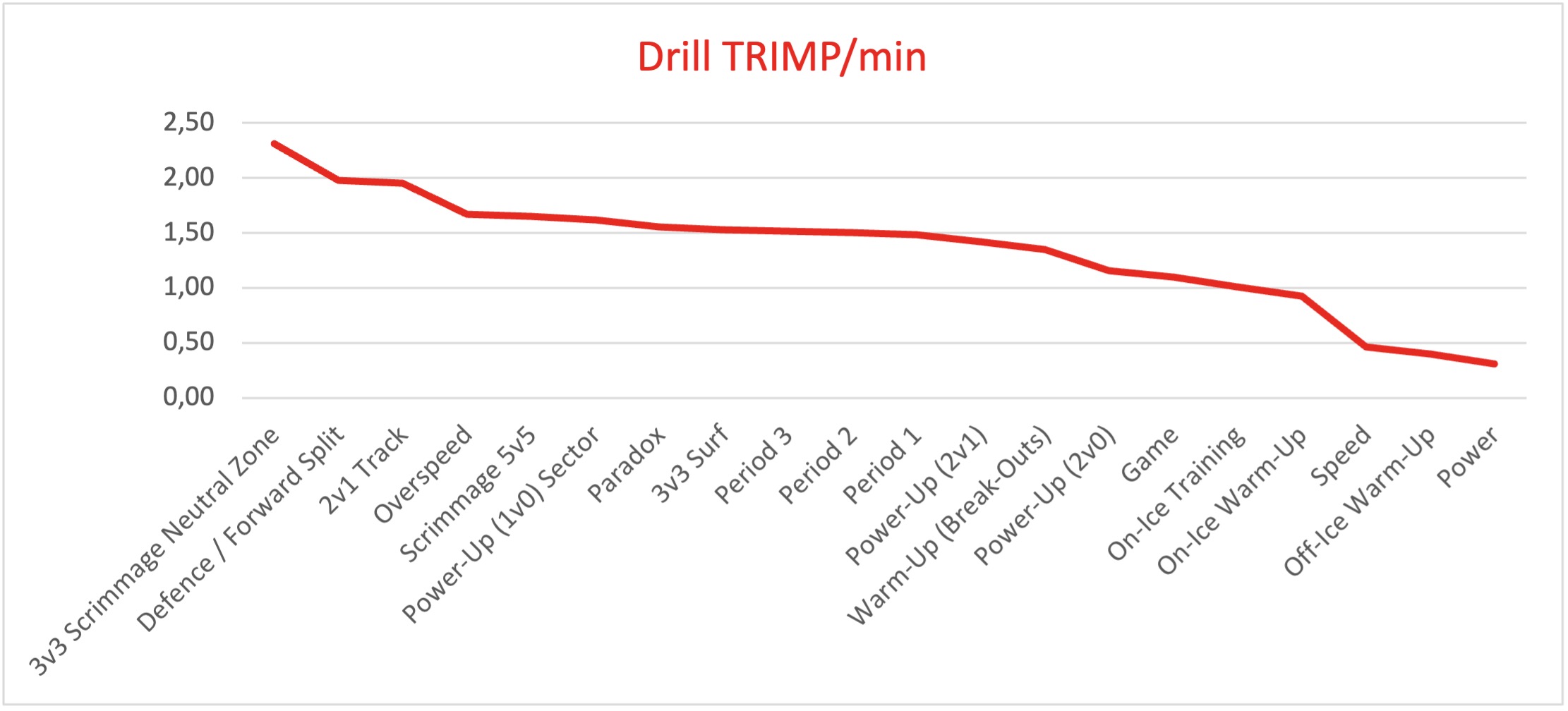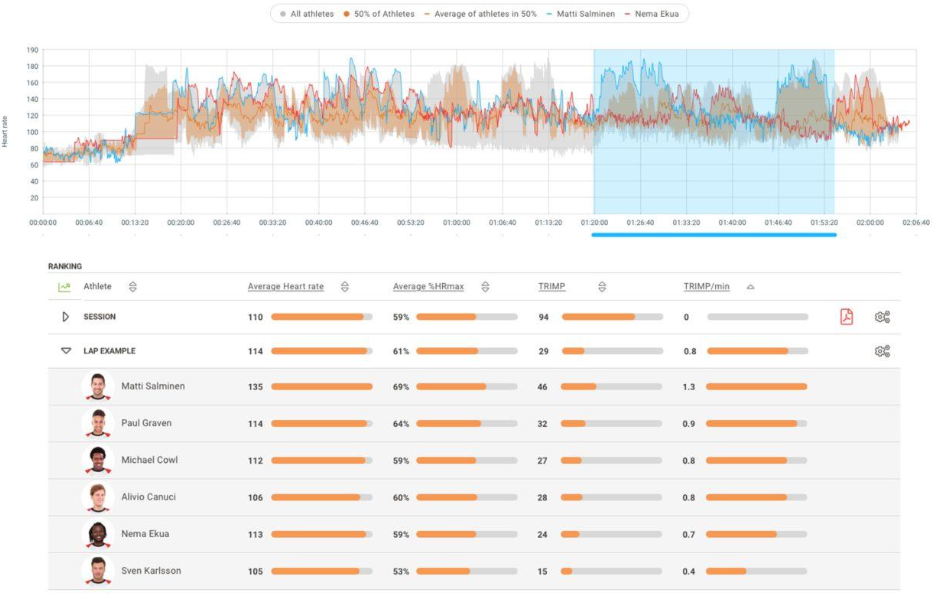
Unlocking the full potential of your athletes and optimizing training requires a strategic approach. The Lap Management tool is your key to achieving this. In this comprehensive guide, we’ll explore how to make the most of this valuable resource. Whether you’re a coach, a sports scientist, or a fitness enthusiast, understanding Lap Management can lead to more informed decisions, better performance, and winning strategies.
By creating laps, you can achieve the following:
- The Power of Lap Management
- Comparing Drill Intensity to Game Intensity
- Establish a library of drills to plan future training more precisely and to communicate with the head coach on how to manage the workload.
- Create a suggested load management plan to help the head coach in making informed decisions.
- Tracking Progress and Conditioning
- Conditioning state of the Individual/Team by Comparing the Same Drill/Exercise Over Time.
- Identifying performance differences among athletes and analyze different segments of the game.
- Return to Play Safely
- Creating a Naming Convention for Drills
Find out how the Lap Management feature works in real-time (video) and post-session (video).
1. The Power of Lap Management
1.1 Comparing Drill Intensity to Game Intensity
- Ensuring your athletes train with the same intensity as during actual games.
- Techniques for analyzing and adjusting training to match game intensity.
Example:
You want your athletes to work as hard in training as they do during the most intense phases of the game, but how can you be certain that they are working with the same level of intensity? The answer lies in comparing the intensity of various drills to that of the actual game.
For instance, let’s assume you’ve defined that the most intense phase of the game registers at 2.5 TRIMP/min. To replicate this intensity in training, you schedule four 2-minute sessions of 5v5 small-sided games (SSG’s) within a single training session. However, examining the TRIMP/min for the entire session won’t confirm whether the desired intensity has been achieved. Therefore, you extract only the periods of play that are of interest, allowing you to analyze the data on both a group and individual basis.
It’s possible that some athletes were able to sustain the desired intensity for all four repetitions, while others were not. Armed with this information, you can tailor your future training, either for the entire group or for specific individuals.

Figure 1. Game intensity vs. Small sided game intensity
In this example, the coach couldn’t replicate game intensity with a 5v5 SSG by examining TRIMP/min, Movement Intensity, Average Heart Rate (Avg. HR), and Average Percentage of Heart Rate Max (Avg. %HRmax). Consequently, it’s likely that a 5v5 SSG is not the ideal game format to mimic game intensity for this team. To achieve the desired intensity, alternative drills are needed.
1.2 Building a Drill Library
- Creating a repository of historical data to manage training loads effectively.
- Practical insights for planning future training sessions.
Example
Creating laps allows you to establish a drill library, aiding in better load management and communication of the physiological demands of specific drills. This drill library is built upon your historical data.
In this example an ice hockey team that has recorded various drills and game segments. This information can be invaluable for assessing the load of upcoming training sessions.

| Drill | TRIMP/min |
|---|---|
| 3v3 Scrimmage Neutral Zone | 2.32 |
| Defence / Forward Split | 1.98 |
| 2v1 Track | 1.95 |
| Overspeed | 1.67 |
| Scrimmage 5v5 | 1.66 |
| Power-Up (1v0) | 1.62 |
| Paradox | 1.56 |
| 3v3 Surf | 1.53 |
| Period 3 | 1.52 |
| Period 2 | 1.5 |
| Period 1 | 1.49 |
| Power-Up (2v1) | 1.42 |
| Warm-Up (Break-Outs) | 1.35 |
| Power-Up (2v0) | 1.16 |
| Game | 1.1 |
| On-Ice Training | 1.01 |
| On-Ice Warm-Up | 0.93 |
| Speed | 0.47 |
| Off-Ice Warm-Up | 0.4 |
| Power | 0.31 |
Figure 3: Open as an image to see the table on mobile device. An Ice Hockey teams simplified drill library as a table. Intensity defined as TRIMP/min.
Once you have successfully compiled the library, you can use the data to evaluate the training loads for future sessions. This means multiplying the TRIMP/min by the planned duration of the drill. As a result, you will obtain the total TRIMP for that session.
The head coach highly values this information, as it provides a better understanding of the drills in use and allows for improved planning of training sessions in collaboration with the Strength and Conditioning (S&C) Coach.
| MD-1 Team Session | Duration (min) | TRIMP/min | TRIMP |
|---|---|---|---|
| Off-Ice Warm-up | 20 | 0.4 | 8 |
| Power | 25 | 0.31 | 7.75 |
| Warm-Up (Break-Outs) | 5 | 1.35 | 6.75 |
| Power-Up (1v0) | 5 | 1.62 | 8.1 |
| Power-Up (2v0) | 8 | 1.16 | 9.28 |
| 3v3 Scrimmage Neutral Zone | 12 | 2.32 | 27.84 |
| 3v3 Surf | 10 | 1.53 | 15.3 |
| 5v5 Scrimmage | 10 | 1.66 | 16.6 |
| Total | 95 | 1.05 | 99.6 |
Figure 4.Open as an image to see the table on mobile device. Ice hockey team’s training session plan.
By integrating the tactical insights from the head coach with the S&C Coach’s consideration of intensities and loads required, this comprehensive approach helps plan training sessions as effectively as possible. The target for MD-1 was to achieve a TRIMP/min range of 0.9-1.1 and a total TRIMP range of 80-120.
In this example, the S&C coach and the head coach utilized the drill library to define the training load before practice. By employing the drill library, they can easily adjust the number of drills, drill durations, or select different drills to fine-tune the intensity and load, while also accounting for tactical elements of the drills.
1.3 Suggested Load Management for Team Practices
- Integrating drill library data into your weekly training plan.
- Optimizing training content to achieve peak performance.
| Team Session Load Management | GD-5 | GD-4 | GD-3 | GD-2 | GD-1 | GD |
|---|---|---|---|---|---|---|
| Total scrimmage duration (min) | 30 | 30 | 30-35 | 25 | 15 | 48 |
| Half court games (min) | 30 | 20 | 10 | 10 | 5 | 0 |
| Full court games (min) | 0 | 10 | 20-25 | 15 | 10 | 48 |
| Suggested Load, total (TRIMP) | 100-150 | 150-180 | 180-220 | 150-170 | 80-120 | 180-280 |
| Suggested Intensity, total (TRIMP/min) | 0,5-1,5 | 1,0-2,0 | 1,5-2,5 | 1,0-2,0 | 1.5-2,5 | 1,5-2,5 |
| Content of the day | Team Practice | Lift+Shooting+ Team Practice | Shooting+Team Practice | Lift+Shooting+ Team Practice | Team Practice | Game |
Figure 5:Open as an image to see the table on mobile device. A modified version of a suggested Load Management Plan for Team Practices (First half of the Season) from a Basketball Team.
By integrating data from the drill library into the weekly plan, it becomes possible to optimize the content of a week to the highest degree.
2. Tracking Progress and Conditioning
2.1 Tracking the Conditioning state of the Individual/Team by Comparing the Same Drill/Exercise Over Time
- Incorporating sub-maximal runs and fitness tests.
- Comparing internal responses over time to assess player conditioning.
Example:
A team may regularly conduct sub-maximal runs throughout their season to assess a player’s conditioning. This can include a capped 30-15 Intermittent Fitness Test (Buchheit, 2008), a YoYo Test (Krustrup, et al., 2008), or a custom-designed protocol specific to your sport.
The team ensures that each athlete performs the same amount of external work on every occasion, allowing them to compare internal responses over time. To track progress, the drill is clipped within the Firstbeat Sports dashboard or live using the Coach App, and summary data is exported to an Excel file, which is then combined with data from previous test instances. You may choose to compare athletes’ TRIMP or TRIMP/min to monitor their progress. An increase in internal responses could indicate fatigue or detraining, while a reduction suggests improved fitness or freshness.

Figure 6: Internal Responses in Submaximal Fitness Tests, Repeated on Different Dates.
A protocol like this can be seamlessly integrated into your warm-up routine at desired time intervals, providing an easy and simple way to conduct in-season testing without the need for a dedicated testing session, which often requires approval from the head coach.
You can also use drills or small sided games to evaluate your players performance. It is worth keeping in mind that the external demands may vary in this scenario as you cannot precisely control the work demands of an SSG in the same way you can for a fixed protocol. Once the athletes are able to complete the drills/SSG with a lower internal response you could increase the demands, add an extra repetition or increase the game duration to further stress the athletes and continue to develop their fitness. Verheijen (2014) provides some examples of how you may gradually increase the demands placed upon your athletes in order to overload them progressively.
2.3 Identifying Performance Differences Among Athletes and analyze different segments of the game.
- Examining performance in crucial game phases.
- Tailoring strategies for different game segments and individual athletes.
The closing stages of a game are often when athletes are pushed to their limits. Maintaining both physical and mental performance levels during this critical period can be the decisive factor between winning and losing.
When in-game monitoring is available, Lap Management can be used to focus on a crucial phase (e.g., the 4th quarter in basketball or the final 20 minutes of a soccer game) for post-analysis. This allows you to examine the physiological responses of individual players or position groups during that specific moment. Such insights can inform future tactical decisions, substitutions, or identify areas where additional fitness training might be necessary. Additionally, by comparing similar game sections over time using Data Export, you can determine which players are better suited to these moments.

Figure 7: A Comparison of Intensity Levels in Different Game Periods and the Last 10 Minutes of Each Period in a Floorball Match.
In this example, the coach has segmented the game into periods and examined the final 10 minutes of each period to understand how fatigue accumulates towards the period’s end. By focusing on the last 10 minutes, it becomes easier to identify which athletes recover effectively during these critical moments.
The coach has chosen to compare Heart Rate Recovery values during the last 10 minutes of each period. For the 30-second time frame, the values are 34, 35, and 27, while for the 60-second time frame, they are 49, 48, and 35. Based on these values, the coach can deduce that the players aren’t recovering as effectively during the 3rd period. It’s important to consider that the lower Heart Rate Recovery in the 3rd period may be due to increased external work, especially if the team was trailing and had to chase the ball.
However, when evaluating Movement Intensity (external load), the values were 2.31, 1.71, and 1.68. These values suggest that the increased fatigue in the last 10 minutes of the 3rd period is not solely due to greater external work. Instead, it indicates that some players were not as fit as others in terms of recovery between shifts, particularly when compared to the first or second period.
Upon making this observation, the coach examined individual players and found even more significant differences between them.
3. Return to Play Safely
It can be dangerous to expose athletes returning from injury to a high training load straight away. At the same time, coaches need to know how a returning athlete may cope with the intensity of a game. Lap Management can be used to compare the HR, TRIMP (Training Impulse) or other load gauging metrics of a returning player with the rest of the team during a period of the session where you are replicating game intensity.

Figure 8: A Comparison between athletes of TRIMP values for a lap.
Viewing the ranking list for a particular lap shows how each selected athlete has responded. For example, athlete ‘Matti Salminen’ has a significantly higher TRIMP and TRIMP/min score during this period than his teammates.
Learn more about TRIMP and TRIMP/min here
Comparing the results just in this particular portion of the session can help coaches make the all-important decision – is my athlete ready and available to return to competitive play without undue risk?
4. Creating a Naming Convention for Drills
- Establishing a standardized naming protocol for drills.
- Simplifying data retrieval and historical reference for future analysis.
If you plan to clip drills from your training sessions, it’s a good idea to establish a naming convention. This will help you easily locate and compare similar sessions when referencing historical data in the future.
In Table below, we provide a hypothetical example. You can take an element from each column and combine them to create a concise and effective naming protocol. For instance, SSG-4v4-S.

While it’s essential to maintain a certain level of specificity in your naming protocol, avoid excessive detail, such as using precise pitch dimensions. Overly specific names can lead to a database where nothing is repeated.
Learn more about how to make coaching decisions supported by data by downloading our free training load guide for coaches here.
You might also be interested in

Make Confident Coaching Decisions with Firstbeat’s Weekly Reporting
In this article, we’ll introduce the Weekly Reporting feature from Firstbeat Sports. As a coach, you can use this feature to: See key training load data over a 7-day period…

Getting Started with Firstbeat Sports – Leksands IF User Story
Jesper Gillerås is the Strength and Conditioning Coach at Leksands IF, a Swedish ice hockey team competing in the SHL, Sweden’s top-tier league. In this interview, Jesper talks about why…
